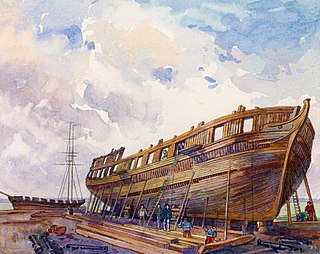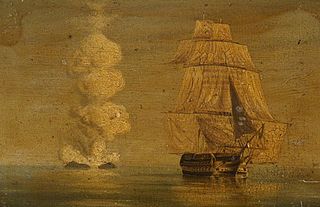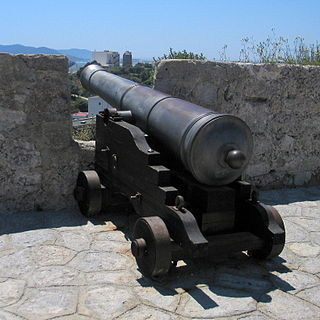Several ships and one submarine of the Royal Navy have borne the name HMS Dreadnought in the expectation that they would "dread nought", i.e. "fear nothing". The 1906 ship was one of the Royal Navy's most famous vessels; battleships built after her were referred to as 'dreadnoughts', and earlier battleships became known as pre-dreadnoughts.
A razee or razée is a sailing ship that has been cut down (razeed) to reduce the number of decks. The word is derived from the French vaisseau rasé, meaning a razed ship.
Seven ships of the Royal Navy have borne the name HMS Niger after the Niger River, whilst another was planned.

The Pelorus-class cruiser was a "third-class" protected cruiser class of eleven Royal Navy warships designed by Sir William White, based on the earlier Pearl-class cruisers. They were ordered in 1893 under the Spencer Programme, and laid down 1896–1900. The first, HMS Pelorus, was commissioned in 1896.

Naval Shipyards, York was one of the shipyards of the Royal Navy on Lake Ontario.
Eight vessels of the Royal Navy have been named HMS Express, or Express:

Provincial Marine was a coastal protection service in charge of the waters in the Great Lakes, the St. Lawrence River and parts of Lake Champlain under British control. While ships of the Provincial Marine were designated HMS, they were operated in more of a coast guard manner than as a full-fledged navy. Operations were maintained and staffed by the Royal Navy. Most ships of the Provincial Marine were built in the Great Lakes.

The Black Prince-class ships of the line were a class of four 74-gun third rates built for the Royal Navy in the closing years of the Napoleonic War. The draught for this class of ship was essentially a reduced version of the captured Danish ship Christian VII.
Eight ships of the Royal Navy have borne the name HMS Siren, Syren or Sirene, after the Sirens of Greek mythology:

The Leda-class frigates, were a successful class of forty-seven British Royal Navy 38-gun sailing frigates constructed from 1805-1832. Based on a French design, the class came in five major groups, all with minor differences in their design. During their careers, they fought in the Napoleonic Wars and the War of 1812. Forty-five of the 47 were eventually scrapped; two still exist.
The Conway class sailing sixth rates were a series of ten Royal Navy post ships built to an 1812 design by Sir William Rule. All ten were ordered on 18 January 1812, and nine of these were launched during 1814, at the end of the Napoleonic War; the last (Tees) was delayed and was launched in 1817.
The Scamander class sailing frigates were a series of ten 36-gun ships, all built by contract with private shipbuilders to an 1812 design by Sir William Rule, which served in the Royal Navy during the late Napoleonic War and War of 1812.

The Arrogant-class cruiser was a class of four protected cruisers built for the British Royal Navy at the end of the 1890s. One ship, HMS Gladiator, lost following a collision with a merchant ship in 1908, while HMS Vindictive saw active service in the First World War, taking part in the Zeebrugge Raid in April 1918 before being sunk as a blockship during the Second Ostend Raid in May 1918.

The Amos Palmer House; is a historic Georgian style home located on Main Street in Stonington Borough, Connecticut. It was built by Captain Amos Palmer in 1787 to replace his former home on the lot which burned after a neighbors' barn caught fire.

The 24-pounder long gun was a heavy calibre piece of artillery mounted on warships of the Age of sail, second only to the 36-pounder long gun. 24-pounders were in service in the navies of France, Spain, Great Britain, the Netherlands, Sweden, and the United States. They were comparable to the Canon de 24 Gribeauval used by the French Army as its largest piece of siege artillery. 24-pounders were used as main guns on the heaviest frigates of the early 19th century and on fourth-rate ships of the line, on the second deck of first-rate ships of the line, and on the second deck of a few large third-rates.
Frederick Whitworth Aylmer, 6th Baron Aylmer was a British Royal Navy officer who fought in the French Revolutionary Wars and the Napoleonic Wars and eventually rose to the rank of admiral. He was born on 12 October 1777 in Twyford, Hampshire, into a naval family which included his great-great-grandfather, Admiral Matthew Aylmer.
This page is based on this
Wikipedia article Text is available under the
CC BY-SA 4.0 license; additional terms may apply.
Images, videos and audio are available under their respective licenses.











